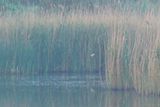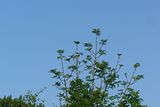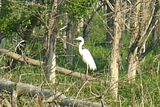Last sunday morning I got up really early, at 4 o' clock. The day before I had seen on the internet that a quite rare bird had turned up at a site that I visit several times a year. Although I'm not a real 'twitcher' I love watching birds and as I had intended to go for a morning walk in the exact area the bird was spotted, this sighting could only make it more exciting. The bird is most active in the dusky hours so I had to change my initial plans and reschedule my trip two hours earlier than I'm used to do. Weather forecasts were excellent, a bright sunny day was expected.
I was heading for two nature reserves called the "Lepelaarsplassen" (lepelaar = spoonbill) and the "Oostvaardersplassen" in a part of Holland called Flevoland (http://en.wikipedia.org/wiki/Flevoland)
Flevoland is "New" manmade land, a polder made out of sea by building dykes around it and then draining the water, leaving a clay based soil below sea level. Most of it is used for agriculture and several cities have arisen on the old seabed but there are a few marshy areas -originally intended to become industrial areas- where nature was allowed to fend for itself and these attract a lot of wildlife that can be hard to find in the rest of the country. In the biggest of these nature areas, the Oostvaardersplassen (http://en.wikipedia.org/wiki/Oostvaardersplassen), 'wild' Heck cattle and red deer where introduced to help stop the marshland turning into forest. The biggest part of both areas is not open for public but there are a lot of surrounding foothpaths, bicycle paths and viewpoints to spot the wildlife. Since a few years a pair of sea eagles is nesting at the Oostvaardersplassen (birds with a sense of humour; they arrived just before the government tried to launch a big and costy reintroduction program ) and there's rumour of a second pair nesting this year.
) and there's rumour of a second pair nesting this year.
I arrived at 5 o' clock at the lepelaarsplassen, before sunrise.

(clicking at the pictures will lead you to my Photobucket account with larger sized pics)
I parked my car beside the road, stepped out and looked at some terns flying above the former sea (the "Zuiderzee", now closed with a dyke to form a giant brackish water lake) on the North and, after crossing the dyke, at rolling reedbeds and grassland in the south. I was immediately immersed in birdsound, the dawning chorus was in full swing. I could hear bluethroat, reed bunting, reed warbler, marsh warbler, sedge warbler, bearded tit, Savi's warbler, cuckoo and little grebe as well as frogs. In the water and muddy areas I could make out several species of duck, grey herons, crested grebes, a great egret, some lapwings and a busy greenshank.
After getting accustomed to the initial 'noise' I also heard two sounds that I had never heard before, one was intrigueing and sounded a bit like a cross between a dripping faucet and a whip, it was the call of a spotted crake (http://en.wikipedia.org/wiki/Spotted_Crake), a very secretive rail that I didn't got to see this day. It is a bird from the Dutch red list of threatened birds
The second noise was the sound I had come for; a soft repetitive barking sound from across the reedbeds, as if there was a small dog hiding in there. After getting as close as possible on the road opposite to the sound and listening in amazement for some 20 minutes the "chihuahua" emerged shortly from the reeds to fly a short distance and disappear into the reedbed again, I had seen my first little bittern (http://en.wikipedia.org/wiki/Little_Bittern). This is a very small heron of reedbeds that used to be a common bird in Holland up till the 1950's but is now firm on the red list. It's numbers have declined over the decades so there are now only a few breeding pairs returning from Africa each spring.
The small bird showed itself once more very briefly from a distance and I managed to get two crappy pictures of a tiny creamcoloured dot in a mass of reedstalks:


not very convincing evidence but I know what I saw.
but I know what I saw.
After watching the sun rise I got in the car again and stopped at two other viewpoints along the dyke. I saw some cormorants, spoonbills, buzzards, marsh harriers and more white egrets in the air. In a wet field some geese, redshanks and lapwings where watching a roe deer pass through:

I than drove to the western side of the Oostvaardersplassen to do some more walking. I found traces of foxes and red deer, saw greenfinches, avocets, bluethroats, some garganey (another Dutch red list bird, http://en.wikipedia.org/wiki/Garganey), a locust warbler and lots of other birds including an osprey flying over. The wild cattle and red deer could be seen in the distance. Sometimes the sea eagles also show themselves here but not this day.

Shy greenfinch, hiding its head behind a branch

White egret, a fairly recent immigrant in Holland
Not much hardcore bushcraft (besides trying to light wood punk, a kind of shelf fungus and some seed fluff in my fire piston) but all in all a good and throroughly enjoyed morning walk, cheers,
Tom
I was heading for two nature reserves called the "Lepelaarsplassen" (lepelaar = spoonbill) and the "Oostvaardersplassen" in a part of Holland called Flevoland (http://en.wikipedia.org/wiki/Flevoland)
Flevoland is "New" manmade land, a polder made out of sea by building dykes around it and then draining the water, leaving a clay based soil below sea level. Most of it is used for agriculture and several cities have arisen on the old seabed but there are a few marshy areas -originally intended to become industrial areas- where nature was allowed to fend for itself and these attract a lot of wildlife that can be hard to find in the rest of the country. In the biggest of these nature areas, the Oostvaardersplassen (http://en.wikipedia.org/wiki/Oostvaardersplassen), 'wild' Heck cattle and red deer where introduced to help stop the marshland turning into forest. The biggest part of both areas is not open for public but there are a lot of surrounding foothpaths, bicycle paths and viewpoints to spot the wildlife. Since a few years a pair of sea eagles is nesting at the Oostvaardersplassen (birds with a sense of humour; they arrived just before the government tried to launch a big and costy reintroduction program
I arrived at 5 o' clock at the lepelaarsplassen, before sunrise.

(clicking at the pictures will lead you to my Photobucket account with larger sized pics)
I parked my car beside the road, stepped out and looked at some terns flying above the former sea (the "Zuiderzee", now closed with a dyke to form a giant brackish water lake) on the North and, after crossing the dyke, at rolling reedbeds and grassland in the south. I was immediately immersed in birdsound, the dawning chorus was in full swing. I could hear bluethroat, reed bunting, reed warbler, marsh warbler, sedge warbler, bearded tit, Savi's warbler, cuckoo and little grebe as well as frogs. In the water and muddy areas I could make out several species of duck, grey herons, crested grebes, a great egret, some lapwings and a busy greenshank.
After getting accustomed to the initial 'noise' I also heard two sounds that I had never heard before, one was intrigueing and sounded a bit like a cross between a dripping faucet and a whip, it was the call of a spotted crake (http://en.wikipedia.org/wiki/Spotted_Crake), a very secretive rail that I didn't got to see this day. It is a bird from the Dutch red list of threatened birds
The second noise was the sound I had come for; a soft repetitive barking sound from across the reedbeds, as if there was a small dog hiding in there. After getting as close as possible on the road opposite to the sound and listening in amazement for some 20 minutes the "chihuahua" emerged shortly from the reeds to fly a short distance and disappear into the reedbed again, I had seen my first little bittern (http://en.wikipedia.org/wiki/Little_Bittern). This is a very small heron of reedbeds that used to be a common bird in Holland up till the 1950's but is now firm on the red list. It's numbers have declined over the decades so there are now only a few breeding pairs returning from Africa each spring.
The small bird showed itself once more very briefly from a distance and I managed to get two crappy pictures of a tiny creamcoloured dot in a mass of reedstalks:


not very convincing evidence
After watching the sun rise I got in the car again and stopped at two other viewpoints along the dyke. I saw some cormorants, spoonbills, buzzards, marsh harriers and more white egrets in the air. In a wet field some geese, redshanks and lapwings where watching a roe deer pass through:

I than drove to the western side of the Oostvaardersplassen to do some more walking. I found traces of foxes and red deer, saw greenfinches, avocets, bluethroats, some garganey (another Dutch red list bird, http://en.wikipedia.org/wiki/Garganey), a locust warbler and lots of other birds including an osprey flying over. The wild cattle and red deer could be seen in the distance. Sometimes the sea eagles also show themselves here but not this day.

Shy greenfinch, hiding its head behind a branch

White egret, a fairly recent immigrant in Holland
Not much hardcore bushcraft (besides trying to light wood punk, a kind of shelf fungus and some seed fluff in my fire piston) but all in all a good and throroughly enjoyed morning walk, cheers,
Tom
